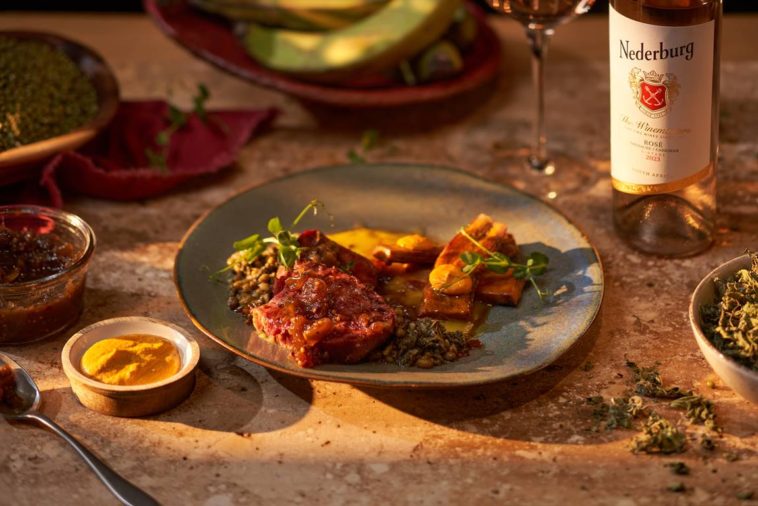Tongue, lerotse, morogo. Just saying the names recalls Gogo’s kitchen of love, comfort and flavour.
Chef Nti Ramaboa combines them with atchar and coconut milk from the East and Dijon mustard from the West.
Her fabulous fusion is fêted with Nederburg’s The Winemasters Grenache Carignan Rosé, an enchanting taste of fresh berry and light spice to bring out the best in this dazzlingly layered dish.
RECIPE: GRILLED BEEF TONGUE
Served on a bed of lerotse purée, plantain chips with coconut atchar mousse, caramelised beans, morogo and lerotse chutney. Paired with Nederburg The Winemasters Grenache Carignan Rosé 2022
INGREDIENTS:
Grilled beef tongue
- 1 beef tongue, about 800g
- 1 unpeeled onion, quartered
- 3 garlic cloves, unpeeled, bruised
- 3 thyme sprigs
- 1 fresh bay leaf
- Olive oil, for drizzling
- Pea shoots/microgreens
Lerotse purée
- 1 cup cubed lerotse (or pumpkin as substitute)
Plantain chips
- 2 ripe plantains (or ripe but firm textured bananas as substitute)
- 2 cups vegetable oil, for frying
- Flour for dusting before frying
- Salt to taste
Coconut atchar mousse
- 2 tbsp olive oil
- 1 cup vegetable atchar
- ½ cup coconut milk
Caramelised ditlwadi and morogo
- 1 cup ditlwadi (mung beans) (or brown lentils as substitute)
- 4 bay leaves
- ½ garlic head
- ½ lemon
- 1 tbsp olive oil
- 3 shallots, finely chopped
- 2 cups dry morogo (or fresh spinach as substitute)
- ¼ cup chopped celery
- 2 tbsp Dijon mustard
Lerotse chutney
- 1 tbsp olive oil
- 3 cups lerotse (or cantaloupe melon as substitute)
- 2 red onions
- 1 lime, grated peel and juice
- 1 thumb-size knob of fresh ginger, grated
- 150ml apple cider vinegar
- 2 tsp cumin
- 2 tsp yellow mustard seeds
- 200g sugar
- 1 fresh chili
- 2 dried chilis
METHOD:
Beef tongue
Combine tongue, quartered onion, garlic, thyme and bay leaf in a large saucepan, cover with plenty of cold water, season generously with sea salt and bring to the boil over high heat. Reduce heat to medium, cover and simmer until tongue is very tender when pierced with a skewer (2½ to 2¾ hours). Drain (discard onion, garlic and herbs) and, when tongue is cool enough to handle, peel and discard the skin. Transfer tongue to a cutting board and cut into slices. Drizzle with olive oil and lime juice and season with paprika. Preheat the grill (indoor/outdoor) to medium heat and lightly oil the grate. Grill tongue slices for 6 minutes, flipping halfway through cook time. Salt and pepper to taste.
Lerotse purée
Bring a large pot filled about ¼ full of water to a vigorous boil. Add in enough lerotse (or pumpkin) to fill the pot, and then cover. When the volume reduces, add more, and continue this process until all the lerotse (or pumpkin) pieces have been added into the pot. Reduce the heat to a gentle simmer, and cook for about half an hour, or until the lerotse (or pumpkin) can be whisked to a smooth consistency. Lerotse has a neutral flavor when raw, but it imparts a unique flavor to the dish when cooked. Drain any water, add to blender, make into a fine purée and set aside.
Plantain chips
Cut off the ends of each plantain. Peel plantains and cut in half crosswise. Using a mandolin slicer, slice plantains lengthwise into planks 3mm thick and dust with flour. Line a rimmed baking sheet with a wire rack. Fill a large, deep cast iron or stainless-steel skillet halfway with oil. Set over medium-high heat until the oil reaches 175°C. Working in batches and avoiding crowding the pan, add plantain slices and fry, turning occasionally, until golden brown all over, about 4 minutes in total. Using a spider or slotted spoon, transfer plantain slices to wire rack to drain. Season right away with salt. Repeat with remaining plantain slices.
Coconut atchar mousse
Add atchar to a blender, with the olive oil and coconut milk. Blend until very smooth and fluffy (2 to 3 minutes). If necessary, add more coconut milk 1 tbsp at a time (or olive oil ½ tbsp at a time) until frothy. Serve warm.
Caramelised ditlwadi and morogo
Meanwhile, place ditlwadi (mung beans) in a small pot and add just enough water to cover. Add ½ garlic head, bay leaves and ½ lemon. Bring to a simmer over medium-high heat and cook until tender, about 25 to 35 minutes. Strain beans, reserving ¼ cup cooking liquid. Discard garlic, bay leaves and lemon. Set beans and liquid aside. In a separate bowl add dry morogo to hot water and let it sit for 5 minutes. Drain and wash the morogo and squeeze with your hands until the slimy liquid runs clear. In the same pot, add oil and shallots and sauté for 5 minutes until translucent. Add chopped celery and sauté for another 3 minutes. Return beans to pot and set over medium heat. Stir in reserved cooking liquid and morogo. Cook until greens just wilt and most liquid cooks off, about 2 minutes. Add mustard. Season with salt and pepper to taste. Cook on high heat for about 2 minutes, remove from heat and let it rest at least 5 minutes.
Lerotse chutney
Add olive oil to a pan over medium heat and gently fry the chopped onion together with lime (zest and juice) and the spices. Let it cook for 10 minutes and then add the lerotse (or cantaloupe melon) in cubes. Let it cook for another 10 minutes, mixing now and then. Add the vinegar and sugar and let cook slowly for an hour. Pour into clean glass containers, close the lids and let it cool upside down. Store in a cool, dark and dry place. Will conserve for at least two years. Let it rest for two weeks before using.
To serve
Slice the beef tongue into the same shape as the plantain chips. Spread a generous serving of the purée on the plate, place plantain chips, and then top the chips with dollops of the coconut atchar mousse. Next to it, place the ditlwadi and morogo, top with the beef tongue and chutney, and garnish with pea shoots/microgreens.



